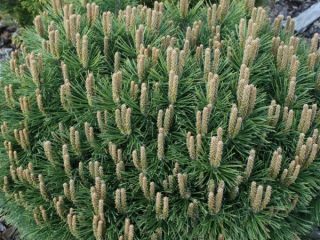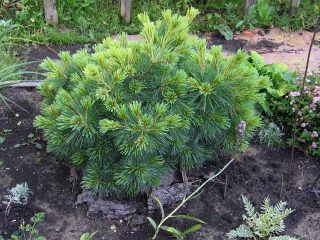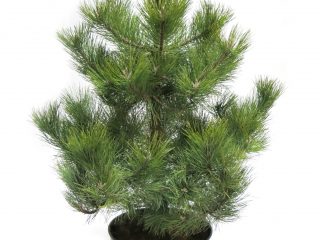Content
Crimean pine is an evergreen tree belonging to the Pine family. The second name of the Crimean conifer is Pallas pine (Latin name - Pinus nigra subsp. pallasiana). This is one of the subspecies of black pine.
Description of Crimean pine
Crimean pine is a tall coniferous tree, reaching a height of 30-40 m, the maximum height is 45 m. The crown of young trees is pyramidal, quite wide, while in older specimens it is umbrella-shaped.
The branches of the Pallas pine are located horizontally, with a slight upward bend.
The bark on the trunk is very dark, brownish or almost black, mottled with cracks and deep grooves. The upper part of the trunk is painted in a reddish tint, young branches are shiny, yellowish-brown in color.
The needles are long, dark green. The needles are very dense and prickly, slightly curved. The length of the needles is from 8 to 12 cm, width – up to 2 mm. The buds are quite large, covered with straight scales.
The cones are located horizontally, on a branch they can be single or several at a time.The color of the cones is brown with shine, the shape is ovoid, conical. The length of Crimean pine cones ranges from 5 to 10 cm, diameter - from 5 to 6 cm. Young shields are painted in a bluish-violet hue, the color of mature ones is brownish-yellow.
The length of the seeds is 5-7 mm, the length of the wing is up to 2.5 cm, and the width is about 6 mm. The dark seed color can be gray or almost black with a dark spot. The wing color is light, the shape is sail-shaped, irregularly oval.
The lifespan of Crimean pine is 500–600 years.
Crimean pine in landscape design
Pines are one of the main elements of the landscape. Evergreen coniferous trees are pleasing to the eye all year round.
Conifers look good both when planted alone and in combination with other trees. Since Crimean pine is a tall species, it is used to decorate alleys in park areas.
Crimean pine is also used to create protective strips and forest plantations.
How to grow Crimean pine from seeds
Growing Crimean pine from seeds is not difficult, if you take into account some of the features of preparing seed material. You can find pine cones in the forest or purchase them at a nursery. Seeds ripen in the fall, so you should go out to collect the cones in the pre-winter period.
The collected cones are placed in a warm, sunny place to dry. It is necessary for the scales to fully open and release the seeds. To speed up the process, you can increase the temperature, but heating the material at high temperatures (more than 45 °C) is not recommended, because seeds may lose their viability.
The germination of Crimean pine seeds is checked by immersing the planting material in a container of water.
After selecting the seeds, they are dried and stored in a cool, dark place until planting.
Seed planting technology:
- The seeds must be germinated 2 weeks before planting in the ground. To do this, they are placed in a damp cloth; the sprouted seeds must have a sprout.
- 24 hours before planting, the seeds are treated with a solution of potassium permanganate.
- Containers for planting must be individual; drainage is placed in the bottom, then a special mixture consisting of sphagnum and crushed pine bark is filled in (ratio 1:4).
- The seeds are carefully placed in the ground and sprinkled, moistened with a spray bottle.
- Containers with seeds are placed in a sunny place.
- The soil is moistened regularly, preventing the soil from drying out.
After the sprouts reach a height of 30 cm, they can be placed in open ground. To increase the chances of survival, experts recommend planting young pines no earlier than after 2–3 years.
In regions with a mild climate, seeds can be planted directly in open ground. To do this, a number of requirements are met:
- the seeds are soaked for several days in water, changing it daily;
- the depth of planting seeds in the bed is at least 3 cm;
- a distance of at least 15 cm is left between the seeds, row spacing should be wide - up to 50 cm;
- the bed with seeds is covered with mulching materials;
- To protect the emerging seedlings from birds and rodents, the beds are covered with film. When the shoots are free of the remaining seeds, the shelter is removed;
- seedlings are transplanted no earlier than after three years;
- During transplantation, soil from a pine forest must be added to the planting hole; it contains mycorrhiza, which helps the seedling to adapt faster.
Planting and caring for Crimean pine in open ground
For planting in open ground, it is best to use a seedling purchased from a nursery or grown from seeds. Trees dug up from the forest very rarely survive after transplantation, so this option should not be used.
Preparing seedlings and planting area
To grow Crimean pine in the country, you need to select the appropriate site. The soil should be sandy or sandy loam. On loamy soils, a drainage layer will be required. The drainage layer poured into the planting hole must be at least 20 cm. Broken brick, crushed stone, and sand are used as drainage. If the soil is highly acidic, it should be limed. To do this, add 300 g of lime to a previously prepared hole and mix it with soil.
The seedlings are carefully removed from the pot or dug out of the soil and, together with a lump of earth, placed in the hole. To transplant pine trees, seedlings aged 3–5 years are purchased from the nursery.
Landing rules
Crimean pine is planted in spring or early autumn. Standard planting hole size:
- depth 70–80 cm;
- diameter – up to 70 cm.
The soil mixture for filling the holes is prepared as follows: mix turf soil with river sand and soil from a coniferous forest in equal quantities, add 30 g of nitrogen fertilizers.
It is necessary to ensure that the root collar does not remain buried in the ground. It should be at ground level.
Watering and fertilizing
Crimean pine is a drought-resistant tree that does not require additional watering. This applies to mature trees, and it is recommended to water seedlings after transplantation to help rooting.
In autumn, young pines must be watered 2-3 weeks before the onset of cold weather. This is necessary to prevent the risk of needles burning in the spring. The crown of the Crimean pine wakes up early, and the dried soil leads to yellowing of the needles. Therefore, moisture-recharging irrigation is necessary for young pines.
The first 2–3 years after planting, seedlings need feeding. It is recommended to apply mineral fertilizers to the tree trunk circle. It is enough to do this once a season (in spring). Mineral compositions are added to each seedling at the rate of 40 g per 1 m² of trunk circle.
Mature pines do not need fertilizing; they only need nutrients accumulated in the coniferous litter.
Mulching and loosening
The tree trunk circle must be loosened periodically. This allows you to improve the condition of the soil and saturate the roots with oxygen. Loosening and removal weed carried out as needed. The earth is not dug too deeply so as not to damage the pine root system.
Mulching helps protect the roots from freezing and prevents the appearance of weeds. Shredded conifer bark, peat, leaves and pine needles are used as mulch.
Trimming
Crimean pine does not need crown formation. If branches are damaged, they are cut down.
Preparing for winter
Mature pines have good frost resistance, but young seedlings may suffer from winter frosts. To prevent damage to the seedlings, they are covered using spruce branches, burlap, and special covering material. Polyethylene film is not suitable for covering, since its use leads to warming of the bark.
Reproduction of Crimean pine
The main method of propagation of Crimean pine is planting seeds. Cuttings or grafting are considered ineffective and are not used when growing Crimean pine.
Planting Crimean pine seeds can be done directly into the ground or into individual containers
Pests and diseases of Crimean pine
The most common diseases of Crimean coniferous trees are:
- root and stem rot;
- rust;
- cancer.
Disease prevention involves proper care of the seedling, as well as treatment with biological fungicides.
Insects can cause damage to pine trees. For young seedlings, the danger is posed by the May beetle, which can damage the root system of the tree. Before planting, it is necessary to carefully inspect the soil; if beetle larvae are found, the soil is treated with chemicals.
Bark beetles damage diseased and young trees. They make passages in the trunk, which leads to a lack of nutrition and the tree gradually dries out. You can see the presence of six-toothed bark beetles by looking at the drill flour on the trunk. For preventive purposes, in the spring, pine trees are treated with bifenthrin-containing preparations.
Insects can cause damage to the needles. For example, pine silkworm caterpillars eat about 700 pine needles during their development period. To combat them, the drugs Aktara, Decis, Karate, and Enzhio are used. Treatment is carried out in autumn or spring.
Conclusion
Crimean pine is a perennial evergreen tree used to decorate park alleys, create forest belts and coniferous plantings. Due to excessive deforestation and population decline, this subspecies is listed in the Red Book of Ukraine and Russia.














